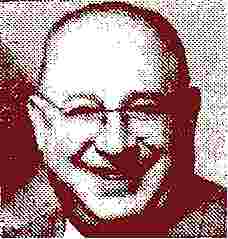

A. BRILL, CARNIVAL LEGEND
 Aaron K. Brill, once known on the midway as
"Headline Harry," is best known in the outdoor amusement business as
the publisher of plans for framing every type of carnival joint. From 1946 to
the late 1970s (Brill died in 1986), Brill drafted and sold plans
for game joints, bleachers, trailers, food stands, magic tricks, fun-houses and
more. A row
of freezer compartments lining his garage wall (bought from a retiring butcher)
held his hundreds of plans, which Brill and his wife would sell for $3 to $50.
His catalog, "A. Brill's Bible of Building Plans," was offered for $1
to readers of the classifieds in Amusement Business magazine, the leading
carnival trade journal.
Aaron K. Brill, once known on the midway as
"Headline Harry," is best known in the outdoor amusement business as
the publisher of plans for framing every type of carnival joint. From 1946 to
the late 1970s (Brill died in 1986), Brill drafted and sold plans
for game joints, bleachers, trailers, food stands, magic tricks, fun-houses and
more. A row
of freezer compartments lining his garage wall (bought from a retiring butcher)
held his hundreds of plans, which Brill and his wife would sell for $3 to $50.
His catalog, "A. Brill's Bible of Building Plans," was offered for $1
to readers of the classifieds in Amusement Business magazine, the leading
carnival trade journal.
 "There are a lot of outfits that will sell
the equipment," he said in a 1975 Chicago
Tribune interview, "but I'm the only one who will sell plans …
A complete merry-go-round can run as high as $50,000. That's crazy. Give me
$10,000 and I can build a complete amusement park, and I'm not talking about a
10-ride kiddieland. I mean a real amusement park with major rides." His
plans were sometimes a bit less than accurate, but that never stopped workmen
with enough skill to take on carnival work. Often, in developing his plans, he
would measure a strut on an existing Ferris Wheel, or a single dimension of a
trailer, and then extrapolate the rest of the dimensions from that single
measurement.
"There are a lot of outfits that will sell
the equipment," he said in a 1975 Chicago
Tribune interview, "but I'm the only one who will sell plans …
A complete merry-go-round can run as high as $50,000. That's crazy. Give me
$10,000 and I can build a complete amusement park, and I'm not talking about a
10-ride kiddieland. I mean a real amusement park with major rides." His
plans were sometimes a bit less than accurate, but that never stopped workmen
with enough skill to take on carnival work. Often, in developing his plans, he
would measure a strut on an existing Ferris Wheel, or a single dimension of a
trailer, and then extrapolate the rest of the dimensions from that single
measurement.
Ex-carny Jim Fletcher, who knew Brill by reputation and once visited him, writes me the following: "I met Brill at his home (trailer) in Peoria, many many years ago. He was a unique man with some novel ideas … Like most "carnys" of that era he believed in little or no government intervention … always a good thing when you make rides out of scrap truck parts! Like a lot of those of that era, he believed it would always be "cash on the grass", but the days of setting up in fields and making a nice profit were drawing to a close. Fairs wanted you to provide Disney Land in the smallest area."
Brill claimed not to have published plans for
rigged games. "Sure I know I could make a lot of money selling the gaff on
a Big Tom," he said to the Tribune interviewer, "but flat stores and
alibis give the business a bad name, and I won't have any part of them."
Nonetheless, Matthew Gryczan, in his book Carnival Secrets, cites Brill's
Six Cat plans: "Some operators weight four cats with flat irons, so two can
be knocked off, but it takes real skill to knock off three. However, as it takes
winners to make your game popular, weighting two  would be more logical."
Again, in his plan for the String Pull game, he advises agents to have
"some real costly prizes for bait." Then the operator can demonstrate
that all the prizes are actually attached to strings, but he should fold the
strings attached to the expensive prizes back in his hand so the player doesn't
get a chance to pull them. He then instructs that those strings can be simply
released by the agent if necessary, or "some well-heeled player might buy
all the strings, and if the big prize doesn't come up, you will have a
riot."
would be more logical."
Again, in his plan for the String Pull game, he advises agents to have
"some real costly prizes for bait." Then the operator can demonstrate
that all the prizes are actually attached to strings, but he should fold the
strings attached to the expensive prizes back in his hand so the player doesn't
get a chance to pull them. He then instructs that those strings can be simply
released by the agent if necessary, or "some well-heeled player might buy
all the strings, and if the big prize doesn't come up, you will have a
riot."
Brill's plans are now collectors' items, their newsprint paper browning and fragile. Copies are available in abundance on eBay, but most of the originals molder in the packed-away trunks of old carnies. Brill himself had no thought of collectors or of carnival history … he was much too busy, he told the Tribune. "Just got a phone call from a bearded lady in Indiana … where's the electric chair plan? … she wanted a disappearing act … look at this ferris wheel diagram … told her I'd get it out to her."